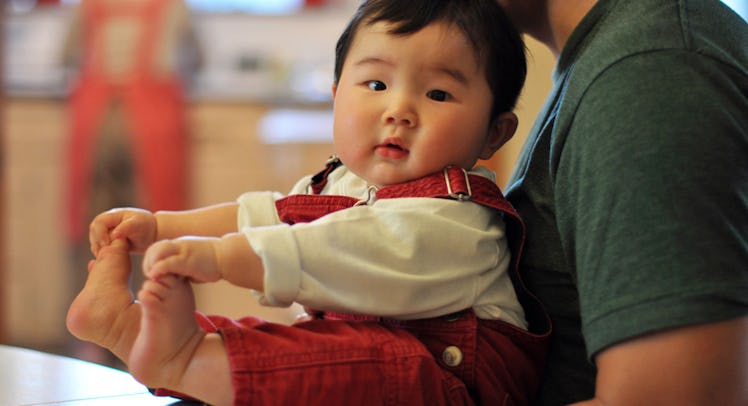How To Tell If Your Toddler Is Chubby, Overweight, Or Obese
This isn't a carnival game.

Even renaissance artists knew that a fat baby was cute as hell. That’s why all those old paintings are so lousy with floaty, winged-bambinos. Chubby kids are squishy, cuddly and also happen to be really easy to chase down. Unless they actually happen to be cherubs, in which case nets and solid reflexes are required.
A parent might consider a toddler’s pudge perfect for a rendering in oil paint. But it also possible that the chubby cheeks are healthy, according to Dr. Stephen R. Daniels, chairperson for the American Academy of Pediatrics (AAP) Committee on Nutrition.
“There’s a long history of thinking a chubby baby is a healthy baby,” Daniels says. He believes that’s based in America’s past, when being undernourished, rather than overnourished, was a deep concern among parents and professionals. “There’s also a concept that babies and children would grow into their weight,” he explains. But these issues are no longer the reality.
Flawed Parental Perception
First, parents are probably not the best at making judgment calls about their kid’s weight. Or at least moms aren’t.
A 2012 study from the University of Maryland showed that 94 percent of moms with overweight toddlers didn’t realize their kids were too big. Considering willing wives seem to be about putting up with dad bod, that may not be terribly surprising. Still, parents need a diagnostic solution besides eyeballing their kid, says Daniels.
“There’s been a shift in population to higher body mass index percentiles,” he explains. “If you’re judging what’s normal based on what you’re seeing around you every day, you’ve lost the concept of what’s healthy and where normal should be.”
And understanding where normal should be is pretty important. Failing to recognize if a child is overweight, and continuing to feed them inappropriately, can set them up for a lifetime of weight struggles. That’s partly why children simply don’t grow into their weight anymore. “The weight gain just continues and continues, even as the growth in height continues,” Daniels says.
Measuring Up
The one surefire tool to use to determine if a kid is overweight or obese is to find their Body Mass Index (BMI). That measure does carry some controversial baggage for adults, mainly due to the fact that the calculation of height and weight doesn’t take muscle mass into account.
“If we’re talking about body builders then that would be an issue,” counters Daniels. “If we’re talking about the average person, I think BMI is a good estimator of your level of body fat.” Also, it’s simple to attain at pediatrician’s office. Furthermore, most toddlers aren’t body builders.
Here’s where parents get to take a deep breath. A kid is not considered overweight if they land anywhere between the 5th and 85th percentile on a BMI growth curve chart. But Daniels notes that hitting that broad target is not as important as a child staying consistent in their percentile.
“Let’s say a child starts at the 50th percentile, but you notice that they’re creeping up,” he says. “I think we should do a better job of identifying kids who are going into that upward direction before flipping into that range that we would call overweight or obese.”
That’s why the doctor urges parents to take a more proactive stance during regular well-child visists. “I would love it if parents would say to their pediatrician, ‘Can I see the chart?'”
Next Steps
If a kid is above the 85th percentile (overweight) or the 95th (obese), it’s important for parents to refrain from overreacting. Not only will it turn them into a wreck and make your life hell, it’s not generally a good idea to make sudden changes to a child’s diet.
“It not about overweight or obesity. The focus should be on healthy eating and physical activity,” Daniels, says. “Create an environment for the child that encourages them to be active on a regular basis and also for the family t have a healthy diet.”
So parents should consider making changes like less sugary juices and processed food and more outdoor play. But Daniels notes that it should be a full household change. Because offering children a series of healthy choices tends to work better than giving them a choice between the unhealthy stuff they love and the healthy stuff parents want them to have.
More than that, Dads can show kids how to eat and play. Because it doesn’t matter if they look like Michelangelo’s David or David Michelangelo (He was that pudgy kid in second grade. Always brought in meatball subs?) — as long as they’re healthy.
This article was originally published on